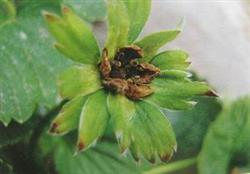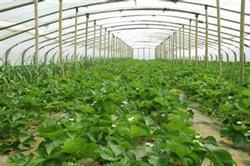What to do about strawberry lack of potassium and magnesium in greenhouse

1. Potassium deficiency: Symptoms of potassium deficiency in strawberries often occur in the upper leaves of new maturity. Black, brown and dry edges often followed by burns, but also in most of the leaves between the veins to the center of development, old leaves seriously damaged. Light can aggravate leaf burns, so potassium deficiency is often confused with sunburn. True petioles of burned leaves often develop brown to dark brown, with slight damage, then gradually wither. The fruits of potassium deficient strawberries are light in color and poor in taste. Control methods: apply sufficient organic fertilizer, about 7.5 kg potassium sulfate per mu; also spray 0.1%~0.2% potassium dihydrogen phosphate solution 2~3 times on leaves, spray once every 7~10 days, spray 50 kg fertilizer solution per mu each time. Magnesium deficiency: initially upper leaf edge yellowing and browning scorched, and then interveinal chlorosis and dark brown spots, some spots developed into necrotic spots. When scorch aggravated, the stem leaves appeared light green and swollen, scorch phenomenon developed with the increase of leaf age and magnesium deficiency. Generally, strawberry is easy to appear magnesium deficiency when cultivated in sandy land or excessive application of nitrogen and potassium fertilizer. Control methods: foliar spraying 1%~2% magnesium sulfate solution 2~3 times, every 10 days or so spray once, spray fertilizer solution 50 kg per mu each time.
- Prev

How to get early ripening and High quality Big Fruit of Strawberry in greenhouse
In recent years, the high-yield cultivation techniques of early-maturing, high-quality and large fruits of strawberries in greenhouse have advanced the market time of strawberries to the middle of December, and the strawberries produced are of good quality, with an average fruit weight of about 30 grams and an average yield of 1800 kilograms per mu. The planting benefit of strawberry was greatly improved. Choose a good seed. The selected strawberry varieties should adapt.
- Next

How to make up for strawberry nitrogen deficiency in greenhouse?
Generally, at the beginning of nitrogen deficiency, the leaves in the peak growth period gradually changed from green to light green, and with the aggravation of nitrogen deficiency, the leaves became yellow, partially scorched and slightly smaller than normal leaves. With the aggravation of nitrogen deficiency, the young leaves became greener. The petiole and calyx of the old leaves are reddish, and the leaves are light or serrated bright red.
Related
- Moge, come on! The staff of the peasant association in the producing area of cantaloupe were frightened when the crowd gathered.
- Causes and Solutions of low Fruit setting rate of Apple
- Symptoms and control measures of passion fruit virus disease
- Fruit growing lesson: how do apple orchards keep high yields?
- Can you build orchards in the mountains? What are the pros and cons?
- How to manage the coloring period of Crisson grape?
- This paper introduces the processing technology of two kinds of fig products.
- How much is a month for retired teachers in rural areas by 2020?
- How can strawberry planting increase sugar content? We should pay attention to management in many aspects.
- What are the cultivation techniques on how to improve the yield of golden fruit?

